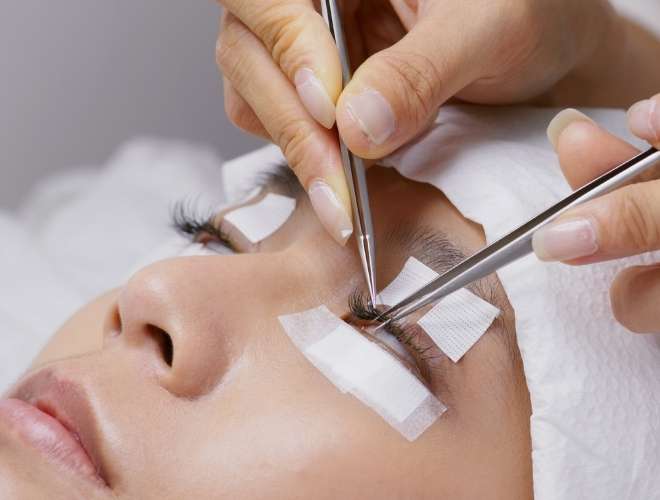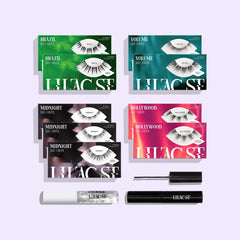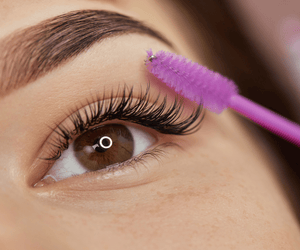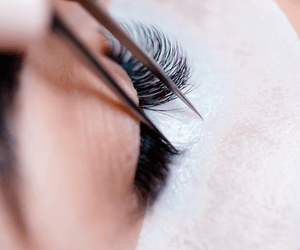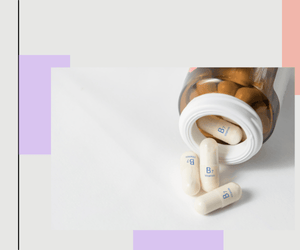You don’t want to sacrifice your health just for the sake of beauty. That’s why researching the safety of the beauty procedures you’re interested in is so important. So are eyelash extensions safe? As it turns out, the answer is complicated.
In this post, we’ll answer this question, cover the risks, and give you some tips for staying safe while still enjoying fuller, more glamorous lashes.
The Safety of Eyelash Extensions
All things in life come with risks, and that includes lash extensions. Is driving safe? No, but that’s why it requires testing and a license! The same logic can apply to understanding if lash extensions are safe.
It’s not hard to come across case studies and horror stories of terrible lash extension outcomes. However, a lot of those risks are the result of either pre-existing sensitivities or of choosing a provider who cuts corners with safety and hygiene. How safe eyelash extensions are, depends greatly on the actual practitioner!
That said, before deciding to go ahead with extensions consider all of the eyelash extensions pros and cons beyond just safety.

The Risks Of Getting Eyelash Extensions
It’s important to understand the risks associated with lash extensions and how likely they are before you decide to go ahead and book an appointment.
Skin Irritation
Skin irritation (i.e. irritant contact dermatitis) usually occurs from the lash adhesive coming in contact with your skin, or from the fumes it lets out as it cures. It usually looks like redness or mild swelling and may feel like a slight itch or stinging.
When done by an experienced lash technician, irritation is less likely. If it does occur, it usually goes away after a few hours. In some cases, it doesn’t subside, in which case it’s important to remove the lashes and even to see a doctor or ophthalmologist.
Eye Irritation
Irritation to the actual eyes can be a little more serious. A little bit of eye redness during and immediately after the lash application is normal and tends to dissipate quickly.
However, lasting eye irritation is a real risk. It can result either from lash glue migrating or from extensions drooping and irritating the eyes. If any of those materials actually come in contact with the eye, irritation can actually be a sign of injury to the lining. In such a case, you should seek the help of a medical professional.
Dry Eyes
Dry eyes are a small but common risk of lash extensions. In some cases, heavy extensions can disrupt the way you blink. This can prevent the meibomian glands on your eyelids from secreting the oil that protects the surface of the eyes.
This issue is most likely to occur if you’re already prone to dry eyes. The risk is also higher if the extensions are too heavy for your eyes or if you don’t clean your lash extensions often enough.
Allergy
Allergic reactions to lash extensions are a little different from run-of-the-mill irritation. Most allergies are to the adhesive. They occur when the chemicals in the adhesive trigger the body’s immune response, and they can affect both the eyelids and the eyes themselves.
Sometimes, an allergy may only show up a few days after the lash extensions have been applied. In other cases, the body can even develop an allergy after months and months of wearing extensions.
If you do experience an allergic reaction, it’s important to deal with it immediately by having the lashes removed professionally. Consult with a doctor or pharmacist if symptoms continue despite removal.
Infection
Infections, either to the eye or the lashline, are by far the greatest lash extension safety risk. It can occur as a result of an untreated allergic reaction or lasting irritation, but it can also occur because of lax aftercare or poor hygiene during the application.
Infections are quite rare, but they can result in very severe swelling, long-term damage, and even blindness.
Loss of Eyelashes
There is a hypothesis that lash extensions can lead to traction alopecia, or eyelash loss because of pressure on the follicle.
In most cases, however, we don’t think that lash extensions will ruin your eyelashes. Correct application techniques focus on limiting the amount of weight that’s placed on each natural lash. Inexperienced lash technicians are much more likely to make mistakes that can lead to lash loss, like applying too much glue, attaching a single extension to multiple lashes, or applying extensions that are too heavy or voluminous for your natural lash line to handle.
Guideline for Avoiding Risks
While the risks associated with lash extensions can seem pretty scary, most of them can be avoided with research and care.
Choose Your Lash Technician Carefully
Choosing a great lash technician will go a long way towards preventing the very worst safety risks of lash extensions, like infection or eye irritation. So what should you look for?
- Check the reviews - positive reviews are a great indication of a lash technician’s skill. Look specifically at reviews that mention things like hygiene practices, the overall environment at the salon, consultations, and the materials available. Photos can also be helpful since you’d be able to see how clients look after they’ve had their lashes done. It’ll also help you make sure that you’re into the technician’s aesthetic.
- Ask about accreditation - most lash technicians working in a salon will be accredited, while those working independently should be vetted more carefully. If you’re not sure, ask about the type of training your technician had when booking the appointment.
- Consultation - make sure to choose a salon or technician that offers some level of consultation. You may have to book an appointment for a consultation, while in other cases, a chat over the phone or at the salon counter can be enough. Coming into the salon is your best bet, though, since you can ask to patch test the adhesive your technician will use.
- Clean salon - if you can, look at photos of the salon itself or drop in before your appointment. A clean environment often correlates with better hygiene standards during the appointment, as well.
Ask About the Adhesive
Your lash technician should be open to sharing information with you about the lash adhesive she uses. In truly excellent salons, there will even be a few different adhesive options to account for allergies as well as for different climates. If you have an allergy that you’re already aware of, let your technician know and have her confirm whether that ingredient is present in the lash adhesive.
Ask for a Patch Test
If your skin is generally sensitive or you’re quite prone to allergic reactions, ask to do a patch test. You can simply have the consultant place a drop of adhesive behind your ear, or she can place a few extensions on the outer corner of your eye. It’s best to wait a few hours to see what happens, so you’ll want to do this during a consultation or while booking your appointment, rather than immediately before your appointment.
Practice Excellent Aftercare
Aftercare is another key aspect of keeping your lashes in great shape. Your lash technician will give you a whole list of things that you’ll need to do to take care of your eyelash extensions, like cleaning your lash extensions every day and brushing to detangle them.
Cleaning is especially important. Demodex mites and bacteria can get trapped near the eyes more easily when there are lash extensions in place, which can lead to eye infections or styes. Clean your lashes carefully every day, and your eyes will be happier, not to mention that your lashes will last longer.
Take Breaks
Some professionals recommend taking the occasional break from lash extensions, while others say it’s not necessary at all. If you think you might be experiencing lash loss or that your lashes are growing more sparsely, consider taking a break for a few months. This will give your lashes time to return to their normal growth cycle.
When to Avoid Eyelash Extensions Altogether
With many eye conditions, it might be better to avoid eyelash extensions entirely, or at least to speak to your doctor before booking your appointment. These are some of those conditions:
- Allergies to common adhesives or formaldehyde
- Chronic dry eyes
- Prone to styes and eye infections
- Rosacea, eczema, or other inflammatory conditions that affect the eye area
- Alopecia areata
If you haven’t been diagnosed with a specific condition, but you have sensitive eyes, lash extensions may not be safe for you, and you should still consider avoiding them.
Alternatives To Eyelash Extensions
If all of the risks of lash extensions sound a little scary or you think that you might not be a candidate in the first place, you’ve got some other options to consider.
DIY Extensions
DIY extensions put all of the control in your hands and problem-solve some of the potential issues with professional extensions. DIY extensions come in clusters that you apply to your lashes from below.
The adhesive for DIY extensions is an eye-safe glue designed to last for up to 5 or 10 days, depending on the formula. It cures almost immediately without emitting any fumes, so it poses less of a risk of irritating the eyes or causing allergies. That said, we’d still recommend patch testing it if you’re allergy-prone or have sensitive skin.
Taking them off if you have any issues is easy to do by yourself with a strong makeup remover or a dedicated DIY extension remover.
DIY extensions have a few other benefits over professional extensions. To start, they’re significantly more affordable. They’re also more convenient - you don’t have to book appointments or worry about refills.
False Lashes
If you only want big lashes for a day, false lashes are another great option. Their main benefit is that, since they’re only worn for short periods of time, they’re less likely to cause an allergy after repeated exposure.
However, wearing them every day might still take a toll since unlike professional and DIY extensions, they sit on the skin rather than on the lashes themselves.
Another note: false lash glue is very likely to contain latex, which is not commonly used in extension adhesive. If you have a latex allergy, make sure to choose your adhesive carefully.
Final Thoughts
Bottom line, are eyelash extensions safe? We think it largely depends on the lash technician you choose, the condition of your eyes, and your diligence with aftercare. As long as you’re aware of potential harm and follow our suggestions for avoiding risks, we think you’ll be just fine!




